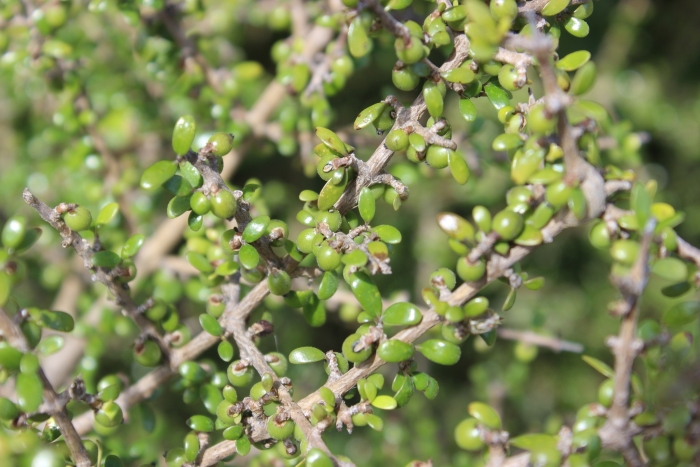Mingimingi
(Coprosma propinqua)
Mingimingi (Coprosma propinqua)
/
/

Joe Dillon
CC BY 4.0
Image By:
Joe Dillon
Recorded By:
Copyright:
CC BY 4.0
Copyright Notice:
Photo by: Joe Dillon | License Type: CC BY 4.0 | License URL: http://creativecommons.org/licenses/by/4.0/ | Rights Holder: Joe Dillon | Publisher: iNaturalist | Date Created: 2020-12-19T12:15:34-08:00 |




















































Estimated Native Range
Summary
Coprosma propinqua, commonly known as Mingimingi, is an evergreen shrub native to the coastal forests, shrublands, and river terraces of New Zealand, including the Chatham Islands. It typically grows to a height of 3 to 6 meters and is characterized by its small, leathery leaves and a dense, twiggy form. The male flowers are inconspicuous, occurring in axillary clusters of one to four on very short branches, while female flowers are solitary at the ends of short branchlets. The fruit is a drupe that matures to a dark blue or blue-flecked color, providing visual interest and a food source for birds.
Mingimingi is valued for its resilience and textural foliage, making it suitable for use as a hedge, screen, or in mass plantings for erosion control. It thrives in full sun to part shade and is adaptable to a range of soil conditions, preferring those with slow to medium drainage. While it requires medium amounts of water, established plants are relatively drought-tolerant. Mingimingi is not commonly afflicted by diseases, but it can be sensitive to root rot in poorly drained soils. Its non-aggressive root system makes it a good choice for urban gardens.CC BY-SA 4.0
Mingimingi is valued for its resilience and textural foliage, making it suitable for use as a hedge, screen, or in mass plantings for erosion control. It thrives in full sun to part shade and is adaptable to a range of soil conditions, preferring those with slow to medium drainage. While it requires medium amounts of water, established plants are relatively drought-tolerant. Mingimingi is not commonly afflicted by diseases, but it can be sensitive to root rot in poorly drained soils. Its non-aggressive root system makes it a good choice for urban gardens.CC BY-SA 4.0
Plant Description
- Plant Type: Shrub
- Height: 12-16 feet
- Width: 2-3 feet
- Growth Rate: Moderate
- Flower Color: N/A
- Flowering Season: Winter, Spring
- Leaf Retention: Evergreen
Growth Requirements
- Sun: Full Sun
- Water: Medium
- Drainage: Slow, Medium
Common Uses
Bird Garden, Edible*Disclaimer: Easyscape's listed plant edibility is for informational use. Always verify the safety and proper identification of any plant before consumption., Hedges, Low Maintenance
Natural Habitat
Coastal forests, shrublands, and river terraces in New Zealand
Other Names
Common Names:
Scientific Names: , Coprosma propinqua, Coprosma propinqua var. typica, Pelaphia parvifolia,
GBIF Accepted Name: Coprosma propinqua A.Cunn.